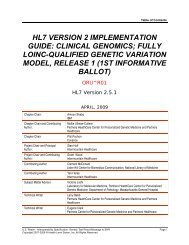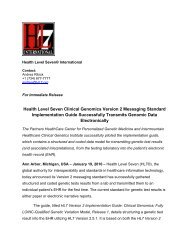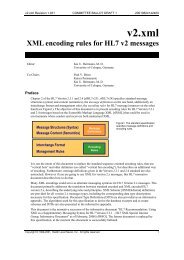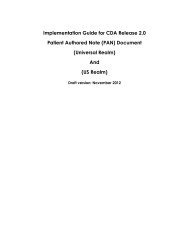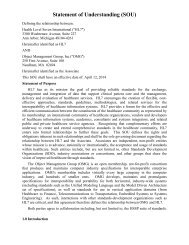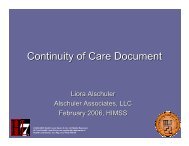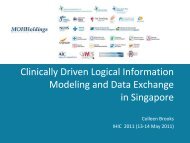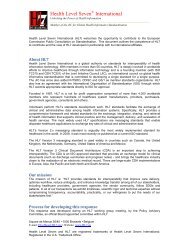HL7 CDA R2 AIS Implementation Guide
HL7 CDA R2 AIS Implementation Guide
HL7 CDA R2 AIS Implementation Guide
You also want an ePaper? Increase the reach of your titles
YUMPU automatically turns print PDFs into web optimized ePapers that Google loves.
<strong>HL7</strong> Additional Information Specification <strong>Implementation</strong> <strong>Guide</strong><strong>CDA</strong><strong>R2</strong><strong>AIS</strong>0000R030Data Type Description RepresentationTSIVL_TSGTSThe value attribute of the elementgives the effective time of the act.The value attribute of the and elementsgive the bounds of the date range. Either or may be omitted to specify a time range that hasno upper or lower bound. While <strong>CDA</strong> permits severalalternative representations of IVL_TS, only therepresentation shown to the right shall be used in <strong>CDA</strong>attachments.Recurring activities can be recorded using the GTS datatype. This is recorded in <strong>CDA</strong> as a series of elements with set operations thatindicate how to combine these. Under thisspecification, the first element mustbe the bounding range, and the second element may further constrain the set to indicate thefrequency (e.g., frequency of visits, or administrations).See section 3.7.16Table 3.6-1 Data TypesThe value attribute shown above records the time and date in the <strong>HL7</strong> date time format, which isdescribed in section 3.7.16 below.3.6.1.4 The element shall be present and points to the narrative text by use of the element. The value attribute shall be a local URI in the form #identifier referencing an element inthe narrative that most closely contains the text to which the entry pertains. A structuredtext element shall be present that has a matching value for identifier in its ID attribute.Use of this mechanism to link the coded entries to the narrative text allows payer systemsreceiving the Computer Decision Variant form to take advantage of the rich information providedin the machine readable entries even when no automated processing of this information isperformed. By linking the entries with the text, codes, times, values, and other information, theentry can be displayed to the human making decisions about the claim.Figure 3.6-1 below shows how this works with an observation.Copyright © 1998-2007 Health Level Seven, Inc. All rights reserved.Release 3.0 Draft StandardPage 49March 2007




